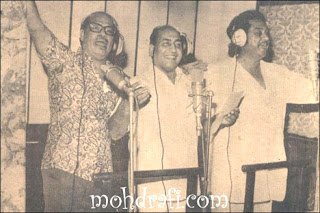Noted litterateur Rabindranath Tagore’s own composed song popularly known as Rabindra Sangeet has been an inspiration for many popular Hindi film songs.Tagore’s composition was first introduced to Hindi cinema in 1941 by Pankaj Kumar Mullick for the film titled Doctor.K L Saigal was the first non-Bengali singer to sing Rabindra Sangeet. Mullick later used the tune of Kharo vayu vayu meghe in the film Zalzala popular song Pawan Chale Zor. The far reaching influences of the Rabindra Sangeet is apparent on several music directors and not all of them were Bengali.
Song from Doctor 1941
Sachin Dev Burman, whose compositions tend to draw upon inspiration from Bengali folk traditions (e.g. bhatiaalii, saari, etc.), have composed several tunes derived from Rabindra Sangeet. Mera sundar sapna beet gaya (Do Bhai, 1947) draws a faint inspiration from O je maane na maana. In fact S D Burman gave us many hit songs from his Bengali Tunes such as Ghum bhulechhi made way for the leisurely Hum bekhdudi mein tumko; Mono dilo na bondhu was turned into Jaane kya tuney kahi(Pyaasa); Dur Kon Parabase became Wahan kaun hai tera musafir jayega kahan (Guide) to name a few.
meraa sundar sapnaa biit gayaa (Do Bhai, 1949): From one of S.D. Burman’s first hit scores in the Bollywood industry, this song is considered to be Geeta Dutt’s breakthrough as a playback singer in Hindi films. The mukhDaa of this song is inspired by a Bilaaval-based Tagore composition called “radono bharaa e basonto.”
Song from Do Bhai, 1947
Nain diivaane (Afsar, 1950): this is another great song based on an extremely popular Tagore composition called “sediin duujane duulechhiinuu bone.” S.D. Burman literally did a copy-paste job here, as the melody of the entire Hindi song is identical to the Bengali original.
Song from Afsar, 1950
Jaayen to jaaye.n kahaan (Taxi Driver, 1954): S.D. Burman modified the raga of his composition to more closely resemble Jaunpuri, the first line of the mukhDaa is instantly recognizable as the main phrase from Tagore’s Bhairavi-based classic “ he khoniiker otiithhii.”
Song from Taxi Driver, 1954
Jalte hai.n jiske liye: (Sujata, 1959): the mukhDaa is taken directly from a Tagore composition named “ekodaa tumii priye.”
Song from Sujata, 1959
tere mere milan kii yeh rainaa (Abhimaan, 1973): By far, this is the most famous example where S.D. Burman has been inspired by Rabindra-sangeet.
Song from Abhimaan, 1973
The influences of the Rabindra Sangeet too ran deep in RD Burman’s music. The proverbial Zindagi ke safar mein guzar jaate hain jo makaam, woh phir nahin aate (Aap Ki Kasam, 1974) draws an inspiration from Tagore’s Jaagorone jai bibhaabori. The song Chhoti Si Ek Kali Khili Thi (Jurmana) is highly inspired from Tagore’s Basante Phul Ganthlo. here I’d like to draw your attention to a collection of S.D. Burman compositions that are derived from Rabindra-sangeet:
Song from Aap Ki Kasam, 1974
R D Burman also used Tagore’s Gram chara oi ranga matir path’s tune instrumentally in the cross line of the song Jab bhi koi kangana bole (Shaukeen). RD Burman’s last movie 1942 A Love Story (1994) had heavy Bengali influences in Kuch na kaho and Yeh safar bahut hai kathin magar. And the Kavita Krishnamurthy solo Pyar hua chupke se is also influenced by Rabindra Sangeet.
Song from Shaukeen 1982
Rajesh Roshan was very much influenced by Rabindra Sangeet many of his songs were inspired by Rabindra Sangeet.One of his great songs Chhokar Mere Mann Ko from Yaarana was inspired by this song Tomar holo shuru, amar holo shara.
Song from Yaarana 1981
In the present Century of Indi Pop or Bhangra Music we can sometime hear beautiful melody from Bengal."Piyu bole" from Pareenita 2005 is one such composition from Shantanu Moitra.And thus Bengal’s music continues to leave its lyrical and melodious stamp in Hindi film music…
Song from Pareenita 2005
.












